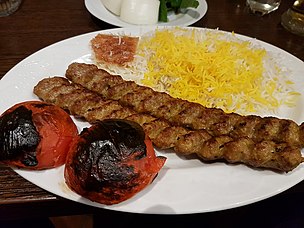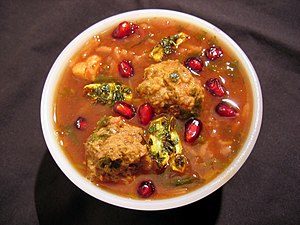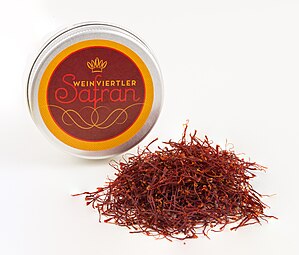Persian cuisine
Iran's culinary culture has historically interacted with the cuisines of neighboring regions, including Caucasian, Turkish, Levantine, Greek, Central Asian, and Russian cuisines. Through the various Persianized Muslim sultanates and the Central Asian Mughal dynasty, aspects of Iranian cuisine were also adopted in Indian and Pakistani cuisine.
Typical Iranian main dishes are combinations of rice with meat, vegetables and nuts. Herbs are often used along with fruits such as plums , pomegranates , quinces , apricots, and raisins . Characteristic Iranian flavors such as saffron , dried lime and other sources of acidic flavorings, cinnamon , turmeric and parsley are mixed and used in various dishes.
Main courses

-
Kabāb : Generic term for grilled dishes, especially meat on skewers, which is mainly cooked on charcoal and served with fragrant rice. In Iran, Kabābs are mostlyeatenin restaurants (the so - called Tschelo -Kabab or Juscheh Kabab ), as they can be best prepared there (in the appropriate ovens).
- Tschelo Kabāb (with Kabāb-e Barg ): Iranian nationaldishconsisting of
- Kabāb-e Kubide : Kabāb made from minced meat and rice
- Djudsche Kabāb (chicken kabāb): pieces of chicken pickled in a marinade of lime juice, olive oil, onions, saffron and salt and fried in / on the charcoal oven.
- Beryan : This dish is cooked from minced meat (preferably minced sheep lung) in a large spoon that is placed in an oven. Then this cooked minced meat is placed on a piece of lava bread and the bread is folded. This dish is a specialty dish from Isfahan City.
-
Chorescht : meat sauce - typical Persian dish in different variations, which is served with lightly fragrant rice. There are many variations of the Choreschs. This type of dish is mostly cooked at home and is rarely found in restaurants. Outside of Iran, however, Khoresh is often on the menu.
- Chorescht-e fesendschān , consisting of ground walnuts, cubed chicken or lamb, pomegranate syrup and spices
- Chorescht-e Gheime , based on tomato sauce, consisting of lamb or veal cubes, yellow lentils, fried onions, dried limes, French fries strips and spices
- Chorescht-e Ghorme-Sabsi , one of the most popular Choreschs based on red beans, various herbs and cubes of meat
- Chorescht-e Karafs , celery-peppermint meat sauce
- Chorescht-e Hawidsch , a carrot-Chorescht
- Chorescht-e Ālu , mirabelle meat sauce
- Chorescht-e Rivas , a rhubarb Chorescht
- Kaleh pacheh , stew made from mutton heads and claws (similar to Armenian chasch )
rice dishes
-
Rice ( Berendsch ), long grain rice forms the basis of many dishes in Persian cuisine. Berendsch only refers to uncooked or unsteamed rice. There are four ways to prepare rice:
- Tschelo : Buttered and steamed rice. The rice is - if no special automatic rice cooker is used - only half cooked in the first step. In a second step, the bottom of the pan is covered with butter and bread or potato slices, the rice is placed on top and simmered on a low level. A rice crust, the tahdig ,forms on the bottom of the pot, which is considered a special delicacy.
-
Polo ( pilaf ): Rice dishes with lentils, field beans, barberries , sour cherries, apricots, carrots, green beans, herbs and pasta
- Schirin Polo , sweet rice dish with chicken (or lamb), barberry, saffron, also with ground pistachios and walnuts.
- Tah Tschin Polo , chicken / duck yogurt rice and saffron
- Kate : Boiled rice
- Dami : Undercooked rice
Soups ( Āsch )
Bread ( nān )
For breakfast, thin flatbread is served, which is eaten with sheep's cheese and butter or jam. There is also black tea.
Types of bread (only white flour products):
- Nān-e Barbari : Thick and oval shaped, sprinkled with cumin and sesame seeds.
- Nān-e Lavāsch : Thin but large flatbread, similar to a crepe. The standard bread.
- Nān-e Sangak : Thin and oval, baked in a stone oven, sometimes on hot pebbles.
- Nān-e Tāftun : thin, soft and round.
Side dishes and snacks
- Torshi : vegetables pickled in vinegar or brine (e.g. cauliflower, carrots, celery, etc.)
- Sabsi : Side dish made from chives, parsley, basil, thyme, radishes and raw onions (as an appetizer) during the main course
- Māst , a (sour) yogurt that is available with most meals with rice and meat
- Mast-o-chiar , a the Tzatziki comparable cream consisting of yogurt, grated cucumbers, dried and crushed peppermint / dill, (walnuts, raisins, spring onions, garlic (optional)) and salt (possibly pepper) and a dash of olive oil
- Borani : Food made from yoghurt combined with vegetables such as spinach, eggplant, beetroot or celery
- Tochme : various roasted and salted seeds such as pumpkin seeds, sunflower seeds and melon seeds that are still in their shells
- Halim Bademdschun : Starter made from crushed aubergines with whey or cream
Salads ( Sālād )
In Persian cuisine, too, there are various salads , often with chives-like vegetables, with salad sauce.
- Sālād Olivieh , potato salad with chicken
- Sālād Schirāzi onions, cucumber, tomatoes with lime sauce
Desserts and fruits
- Baghlavā : a pastry made from puff pastry or filo pastry in sugar syrup, filled with chopped almonds or pistachios.
- Scholeh-sard : rice pudding with sugar, rose water, possibly almond slivers, colored yellow with saffron, decorated with cinnamon.
- Ferni : fine dessert made from rice flour, sugar and milk, briefly boiled.
- Halva arde : roasted flour, quenched with hot saffron-sugar-rose water. Dough-like consistency.
- Katschi (Katchi): Saffron cream, meal made from flour, fat and saffron.
- Lavaschak : thin plates made of dried syrup (barberry, tamarind or other fruits).
- Bamieh : pancake-like batter fried in hot oil and quenched with sugar-rose water and served cool.
- Gaz : similar to white nougat, made from egg whites,tragacanth( Astragalus adscendens ) exudate, sugar and pistachios or almonds.
- Fālude : popular Persian ice cream in the form of noodles and mostly with a lemon flavor.
- Pashmak : a type of Persian cotton candy .
- Pulak : small slices of caramelized sugar.
beverages
- Tschāi : Tea , unsweetened, the sugar is put into the mouth in pieces.
- Sharbat : fruit or herb juice, often made with rose water or rose syrup.
- Dugh :yogurt drink, comparable to the Turkish Ayran and the Indian Lassi .
- Sekandschabin : syrup made from honey and vinegar, which - often mixed with mint - is used to prepare drinks and as a sauce.
Other
- Ghalyun : The water pipe filled with flavored tobaccois occasionally smoked after eating.
- Advieh : A variablemixture of spicesfor the preparation of different rice dishes, meat sauces and meat dishes.
- Gewürzsumach : Sourish spice from the fruit of the tree dyers. It is sprinkled over salads, meat or rice dishes.
- Kaschk : Dried and salted yoghurt mixture that is used to flavor soups or eggplant dishes.
literature
- Najmieh Batmanglij: New Food of Life. A Book of Ancient Persian and Modern Iranian Cooking and Ceremonies . Mage Publishers, Washington (DC) 1992.
- Najmieh Batmanglij: A Taste of Persia . Mage Publishers, Washington (DC) 1999.
- Reza Haidari Kahkesh, Babak Haidari Kahkesh: Culinary delights from Persia . regura-Verlag, Frankfurt / Main 2004.
- Najmieh Batmanglij: From Persia to Napa: Wine at the Persian Table . Mage Publishers, Washington (DC) 2006.
- Cooking. i. In ancient Iran, ii In Pahlavi literature, iii. Principles and ingredients of modern Persian cooking, iv. In Afghanistan . In: Encyclopædia Iranica . S. 246-252 .
- Gabi Kopp: The Persian Cookbook . Publishing house Jacoby & Stuart , Berlin 2013.
Web links
- General information on Persian cuisine
- PersianCity.com: Iranian (Persian) Food Recipes ( Memento from October 5, 2015 in the Internet Archive )
- Recipe collection Persian dishes
- Photos of the Iranian meals
- Encyclopaedia Iranica: Cooking
Individual evidence
- ↑ Persian food. Retrieved January 26, 2020 .
- ↑ Christopher de Bellaigue: In the rose garden of the martyrs. A portrait of Iran. From the English by Sigrid Langhaeuser, Verlag CH Beck, Munich 2006 (English original edition: London 2004), p. 22









